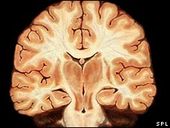
© splTau causes tangles in brain tissue
Scientists have shown a rogue protein thought to cause Alzheimer's can spread through the brain, turning healthy tissue bad.
They believe the tau protein may share characteristics with the prion proteins which cause vCJD.
When injected into the brains of healthy mice it triggered formation of protein tangles linked to Alzheimer's.
However, experts stressed the Nature Cell Biology study did not mean tau could be passed from person to person.
Tau is a protein present in all nerve cells, where it plays a key role in keeping them functioning properly.
But a rogue form of the protein can trigger the formation of protein clumps within nerve cells known as neurofibrillary tangles.
It is thought that these tangles are likely to be a major cause of Alzheimer's disease.
In the latest study researchers, led by a team from University Hospital, Basel, extracted sections of brain from mice expressing a mutant form of human tau protein.
These extracts were injected into specific regions in the brains of healthy mice.
New tanglesAnalysis showed that this induced normal human tau proteins in the healthy mice to clump together to form neurofibrillary tangles.
These newly-formed tangles were also able to spread to nearby regions in the brain.
Another type of rogue protein - the prions - which cause diseases such as vCJD, are thought to be able to twist themselves into a shape which gives them the ability to "infect" nearby healthy tissue.
But until now it had not been thought that tau proteins had the same contagious property.
Dr Michel Goedert of the MRC Laboratory of Molecular Biology in Cambridge, worked on the study.
He said: "This opens new avenues in dementia research that will aim to understand how abnormal tau can spread.
"We can also investigate how diseases caused by tau aggregates and prions are similar."
Disease progressionProfessor David Allsop, an expert in neuroscience at Lancaster University, said the study might help explain how tangles spread from one region of the brain to another during the course of Alzheimer's.
However, he said: "This does not mean that these diseases are infectious in the same way as mad cow disease and human CJD.
"There is no evidence that diseases like Alzheimer's disease and Parkinson's disease can be transmitted from one person to another."
Rebecca Wood, chief executive of the Alzheimer's Research Trust, said: "This greater understanding of how tangles spread in Alzheimer's may lead to new ways of stopping them and defeating the disease."
However, Dr Susanne Sorensen, head of research at the Alzheimer's Society, stressed that work was carried out in genetically modified mice, and there was a lot of work to be done before the implications were fully understood.
"There is still so much we do not understand about the changes in tau that lead to tangle formation in humans and, eventually, widespread brain cell death," she said.

Reader Comments
to our Newsletter